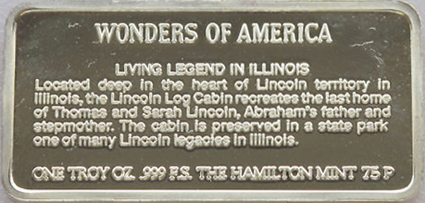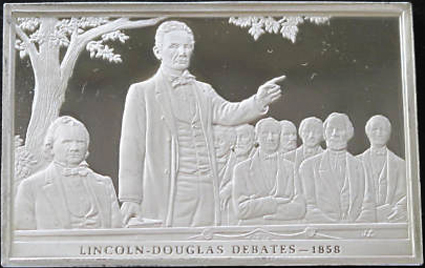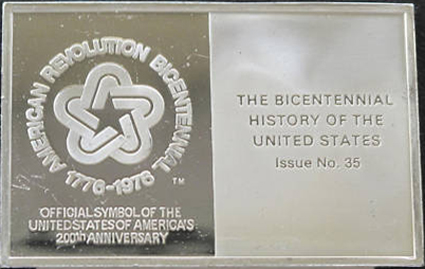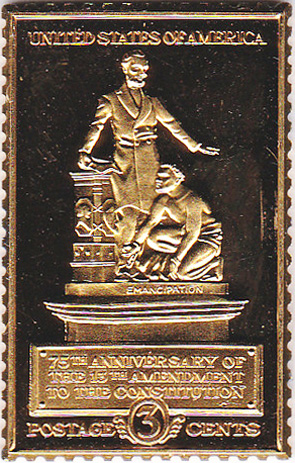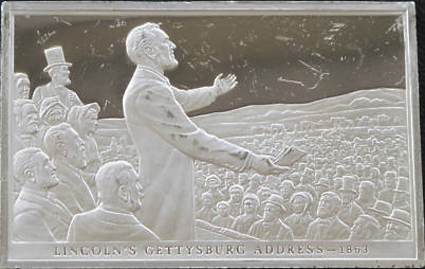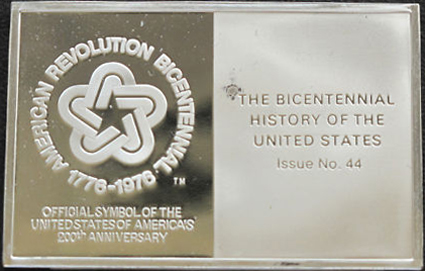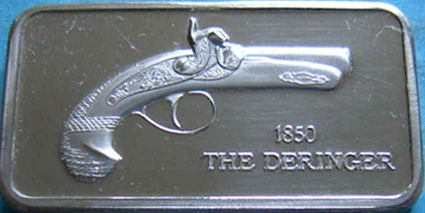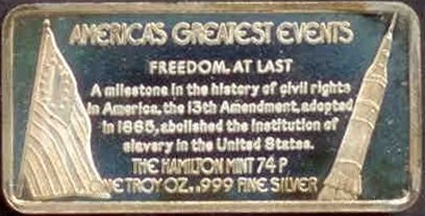
 |
 |
|
| |
||


Abraham Lincoln Life Story in Silver Bars
Lincolniana is Abraham Lincoln memorabilia and ephemera in a variety of formats, ranging from the serious and scholarly, to the outright silly and satirical. Here are some Lincoln collectibles in the category: "Silver Bars." The silver bars and ingots on this page commemorate important milestones in the life of Abraham Lincoln. See also: Abraham Lincoln silver bars Born in a Log CabinAbraham Lincoln was born February 12, 1809, in Hardin Co., Kentucky. His parents Thomas and Nancy, and his sister Sarah, lived in a log cabin. After Nancy Hanks Lincoln died, Thomas married Sarah Bush Johnston. They, too, lived in a log cabin--in Illinois. This cabin is commemorated in the Lincoln Log Cabin silver bar from The Hamilton Mint's "Wonders of America" series. It is one troy ounce of .999 fine silver. The front of the bar shows the log cabin, and the back includes this inscription:
Lincoln-Douglas DebatesAbraham Lincoln ran against the prominent Democrat Stephen A. Douglas for the senate in 1858. Lincoln was unknown and a clear underdog, but he boldly challenged Douglas to a series of debates. The Lincoln-Douglas Debates brought Abraham Lincoln national acclaim, setting him up to run for the presidency in 1860 (though he lost the senate race to Douglas). A sterling silver proof ingot from The Franklin Mint’s “History of the U.S.” collection portrays Lincoln during one of the seven debates: Lincoln Douglas Debates - 1858, issue number 35. The bar is 750 grains (approximately 1.56 troy ounces) of .925 fine silver and measures 2.1” x 1.4”. This collection is an officially recognized commemorative of The American Revolution Bicentennial celebration, which was established by Act of Congress to coordinate the programs and events of the Bicentennial celebration in 1976.
Emancipation ProclamationAbraham Lincoln is known as the Great Emancipator. On January 1863, Lincoln issued the Emancipation Proclamation, which freed the slaves in the Southern states then in rebellion (3.1 million of the 4 million slaves in the U.S. at that time). It had more philosophical power than practical power. That is, the slaves were under Confederate control so they were not practically free, but the Emancipation Proclamation set the stage for eventual universal freedom because it made the abolition of slavery a central part of the war--much to the dismay of many Northerners. The Emancipation Proclamation was issued by Lincoln as an executive order. He did believed it was in his power to do so during the war, but did not believe it would apply on a broad scale Constitutionally during peacetime. Therefore, he pushed for the 13th Amendment, to make emancipation permanent. The United States Postal Service (USPS) created a 3 cent stamp in 1940 to commemorate the 75th anniversary of the 13th Amendment. It featured the Emancipation Group sculpture by Thomas Ball. The stamp is also depicted in a sterling silver bar issued by the USPS. The bar is .925 fine silver.
Gettysburg AddressOn November 19, 1863, Abraham Lincoln rose following the main orator at the Gettysburg National Cemetery, Edward Everett. In a letter to Edward Everett the following day, Lincoln acknowledged the setup of the day: "you could not have been excused to make a short address, nor I a long one." Lincoln's speech was just two minutes long and was not popular in its day, but it became one of his most notable speeches as history remembered him. The speech is depicted on a sterling silver proof ingot from The Franklin Mint’s “History of the U.S.” collection, issue number 42: Lincoln's Gettysburg Address - 1863. The bar is 750 grains (approximately 1.56 troy ounces) of .925 fine silver and measures 2.1” x 1.4”. This collection is an officially recognized commemorative of The American Revolution Bicentennial celebration.
Lincoln's AssassinationJohn Wilkes Booth waited until the last big laugh in Our American Cousin and Ford Theater to pull the trigger and assassinate Abraham Lincoln on April 14, 1865. Lincoln died the next morning. The Assassination of Lincoln - 1865 sterling silver bar from The Franklin Mint's "History of the U.S.," issue number 44, commemorates this tragic event. The bar is 750 grains (approximately 1.56 troy ounces) of .925 fine silver. This collection is an officially recognized commemorative of The American Revolution Bicentennial Administration.
Booth used a single-shot deringer pistol to shoot President Lincoln. The deringer, 1850, is portrayed in the 1975 Lincoln Mint "American Weapons Hall of Fame" collection. The sterling silver bar is one troy ounce of .925 fine silver. The front of the silver bar shows the deringer pistol, and the back contains this inscription:
The Philadelphia Deringer was designed by Henry Deringer and produced from 1852 through 1868. It is unclear why the silver bar bears an 1850 designation.
Posthumous Victory: The Thirteenth AmendmentThe 13th Amendment (which abolished slavery as an institution) passed in the Senate in April 1864, but it was defeated in the House of Representatives when it failed to get a two-thirds majority vote (93 to 65). Abraham Lincoln took a very active role in pushing it through Congress. Only four Democrats in the House had voted for it, so Lincoln used his political skill to convince more to vote for it. It finally passed in the House in January 1865, with a vote of 119-56. It was ratified by the states after Lincoln's death, on December 6, 1865. The silver bar from the Hamilton Mint captures this story in the "America's Greatest Events" series. The silver bar is one troy ounce of .999 fine silver. The front of the bar says, "The 13th Amendment." The back has this inscription:
|
 |
Copyright © 2005-2012 Alta Omnimedia. All Rights Reserved.




